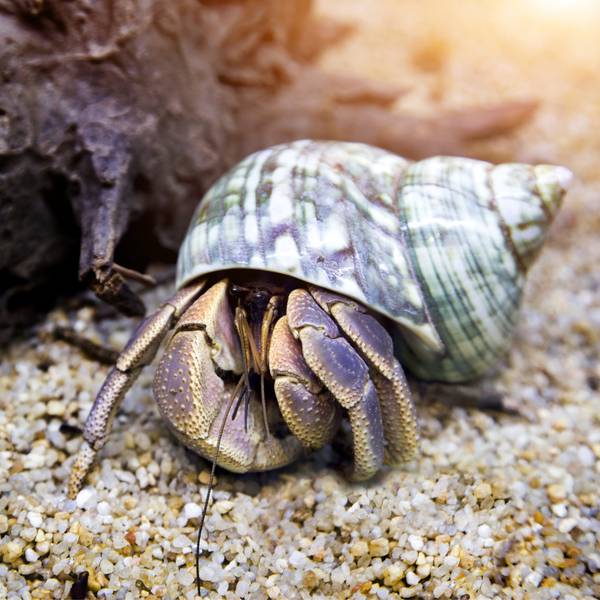Hermit crabs are a fantastic option for transitioning older kids to exotic pets.
Introducing unique, small animals like hermit crabs to kids often helps to alleviate fears of spiders and insects, and they’re more likely to grow into adulthood with more sense and respect for the animal kingdom.
Hermit crabs are quiet, interesting to observe, and, if done correctly, creating and maintaining their environment is an educational experience in itself.
Setting up the environment
Just like with any animal, especially exotic pets, the hermit crab tank must be set up to mimic their natural habitat for them to be happier and live longer.
There are several factors to take into consideration when setting up the hermit crab home. These include tank size, temperature and humidity, substrate, food and water, and furnishings.
The tank
Many new hermit crab parents purchase a small plastic container sometimes referred to as a critter keeper. Although these are perfect as isolation tanks or very temporary homes, they are much too small for everyday living. Knowing that hermit crabs are social creatures and thrive best by living with others of the same species, a 38-283 litre aquarium is an excellent choice for a “crabitat” depending on the size and number of the crabs.
The Hermit Crab Association says, “Each crab needs at least 72 litres of space and even more than that as they grow bigger.” Hermit crabs like to wander and move, especially at night, so they need more space than most people realise. Plus, the tank fills up pretty quickly once the furnishings and substrate are added.
Temperature and Humidity
Hermit crabs require higher temperatures since they are tropical creatures. Most hermit crabs need the heat to range from 22-27 degrees, but if the home is not consistently this warm, then a heater and thermometer will need to be added to the shopping list.
Most hermit crab experts recommend an under-tank heater sold for glass reptile tanks. Place the heater on the back or side of the tank since the thick substrate on the bottom will block the heat from reaching the crab.
Humidity can be tricky if the air con is running, but if there is a water bowl close to the tank’s heater, then the humidity will be better. Ideal humidity is between 70% and 85%, and a Just For Pets pet expert can suggest the perfect hygrometer for the tank.
Substrate
Sand is the best option to mimic the hermit crab’s natural environment because they like burrowing for hiding, pleasure, and moulting (this is how they grow). Crushed coral can also be mixed in with the sand to give it a more natural beach texture, but using chunky substrates like gravel and mulch is not recommended.
Use a spray bottle with dechlorinated water to keep the substrate moist enough to the point where it can hold its shape, like building sandcastles. The slight dampness mimics their natural habitat, helps them to burrow more efficiently, and is essential for successful hermit crab moulting.
Food and Water
Hermit crabs need access to both food and water in separate dishes. Shallow, sturdy reptile dishes are perfect since they are easy to climb over and clean. Hermit crabs are natural scavengers, which means they will eat just about anything available, so you can use a commercially-made hermit crab diet, while also tossing in tiny bits of fruits, vegetables, and dried insects. The crushed coral added to the substrate will also help to keep their exoskeleton strong.
Smithsonian’s Zoo and Biology Institute recommends using two different water dishes: one for fresh, dechlorinated water, and the other for saltwater made with marine aquarium salt. Natural sea sponges placed in water dishes is a creative way for them to hydrate and regulate humidity. Hermit crabs will naturally bathe in these waters as well, so it is entirely unnecessary to hand bathe them. This will actually stress the little guys out!
Furnishings
On to the fun part: decorating the hermit crab environment. The most important accessories to have are those for climbing and hiding. Hermit crabs love to climb and move around, and they need safe zones for hiding and resting.
Most items can be found in a Just For Pets member store, including The Krabooz. This company has a variety of unique materials specific to the hermit crab environment, like a hermit crab condo and a large climbing tree. They even have an app that provides care alerts, a heat map indicator by location, and videos on how to take care of the hermit crab.
Avoid items made from chrome, nickel, arsenic, and cadmium. Decorative moss can be dangerous as it may be toxic. Some safe woods can be collected from the yard as long as they are free of pesticides, fertilisers, and other chemicals.
Owning hermit crabs can be an exciting and educational experience. Caring for and maintaining a hermit crab environment may even make or break the pet parent’s desire for furthering their skills in owning other exotic pets. However, if these guidelines are followed, the experience will be well worth it.






